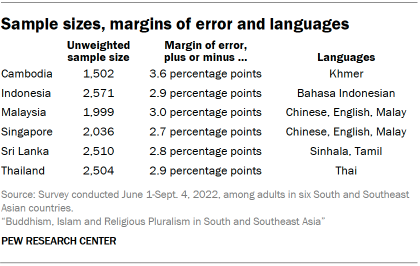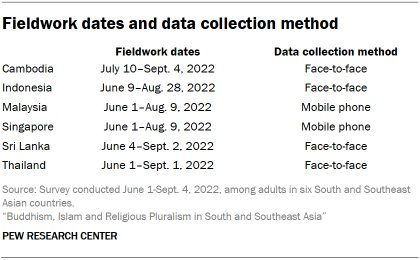Pew Research Center conducted random, probability-based surveys among 13,122 adults (ages 18 and older) across six South and Southeast Asian countries: Cambodia, Indonesia, Malaysia, Singapore, Sri Lanka and Thailand. Interviewing was carried out under the direction of Langer Research Associates. In Malaysia and Singapore, interviews were conducted via computer-assisted telephone interviewing (CATI) using mobile phones. In Cambodia, Indonesia, Sri Lanka and Thailand, interviews were administered face-to-face using tablet devices, also known as computer-assisted personal interviewing (CAPI). All surveys were conducted between June 1 and Sept. 4, 2022.

The surveys were designed to be nationally representative, with samples ranging from about 1,500 to 2,600 respondents in each country, allowing researchers to analyze the opinions of respondents by age, gender, education and religious affiliation. In Thailand, the Southern region was oversampled to ensure a large enough sample of Muslims for analysis.

Fieldwork took roughly 10 weeks for CATI countries and, on average, 11 weeks for CAPI countries. In Sri Lanka, widespread protests against the government forced a brief pause in fieldwork on July 10 and 11.
The phone surveys were based on random-digit-dial (RDD) probability samples of mobile phone users based on national numbering plans. Interviews were conducted with the person who answered the phone, if that person was 18 years of age or older. Up to seven attempts were made to complete the interview. In Singapore, only permanent residents and citizens were selected to take the survey to align with national census data for weighting.
In the face-to-face samples, the surveys were administered using random household selection. All samples are based on multistage cluster designs, which typically entailed proportional stratification by region and locality size or urbanicity and selection of primary sampling units (PSUs) proportional to population size. Interview teams were assigned to designated starting points at the block or street level and followed predetermined skip patterns to contact a random selection of households. Within households, the CAPI device randomly selected a respondent to be interviewed from a detailed list of all adult household members. In Indonesia, about 5% of the total population could not be accessed due to insecurity, poor infrastructure or extreme remoteness. In Thailand, about 2% of the population was inaccessible due to security concerns.
The questionnaire was designed by Pew Research Center staff in consultation with subject matter experts and project advisers. Early in the development process, three focus groups were conducted in Sri Lanka and three more were held in Thailand to explore and identify key topics related to religion, intergroup relations and nationalism. Additionally, two cognitive interviews were conducted in Thailand to test the wording of several questions and concepts. All qualitative work was overseen by Ipsos MORI. The full survey questionnaire was pretested in all countries prior to fieldwork. A small number of political questions were moved from the start of the survey to the end in Sri Lanka due to political sensitivities, in order to decrease the likelihood of refusals and breakoffs.
In Singapore and Malaysia, samples were weighted using iterative proportional fitting (raking) that matches age, gender, education and regional population distributions in the sample to parameters from the latest census data available for each country. For the face-to-face countries, the data was first weighted to account for different probabilities of selection among respondents. It was then raked to align the samples with official population figures for age, gender, education, urbanicity and region, including aligning the Thai Southern oversample with its actual share of the population. Statistical tests of significance are adjusted to account for the survey’s design (e.g., cluster sampling in face-to-face countries) and weighting applied (e.g., selection probabilities and raking to census parameters).
Our website also has more information on country-specific sample designs for this study and general information on international survey research at Pew Research Center.




